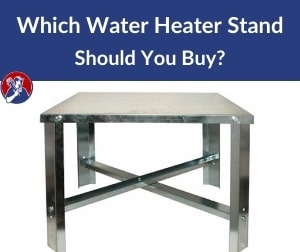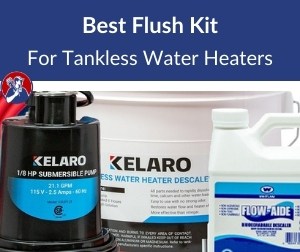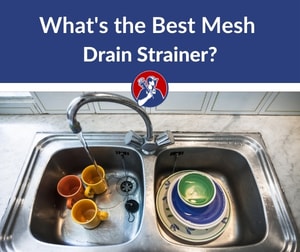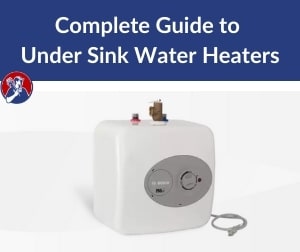
You just want to have hot water to wash dishes with or take a relaxing shower, but it seems like the water is taking its sweet time to heat up. If this is a common problem in your home, installing an under sink water heater, or point of use water heater, can offer the instant hot water you are dreaming of!
But, how do you pick the best under sink water heater for your home? We’re here to help …
In this PlumbingNav guide, we will cover:
- What are the different types of under sink water heaters?
- How do under sink water heaters work?
- What do you look for in under sink water heaters?
- Best under sink water heater (2021 Review)
| Image | Product | |||
|---|---|---|---|---|
Best Overall  | Best Overall | Bosch Electric 7 Gallon Mini-Tank Water Heater Tronic 3000
|
| View on Amazon |
Best Value  | Best Value | Ariston Andris 4 Gallon Mini-Tank Electric Water Heater
|
| View on Amazon |
Best High-End  | Best High-End | Rinnai V75iP Propane Tankless Hot Water Heater, 7.5 GPM
|
| View on Amazon |
Best Efficiency  | Best Efficiency | Stiebel Eltron Tankless Water Heater – Tempra 24 Plus, 3.1 GPM
|
| View on Amazon |
Best Single Faucet  | Best Single Faucet | ECOTOUCH ECO90 Electric Tankless Hot Water Heater, 1.5 GPM
|
| View on Amazon |
Our Overall #1 Rated Pick
Updated On August 25, 2025
Our #1 Rated Pick: Bosch Electric 7 Gallon Mini-Tank Water Heater Tronic 3000
This 120v electric mini-tank water heater provides 7 gallons of water from a 29.5-pound unit at 98% efficiency. The device comes with a magnesium anode rod to prevent corrosion. Turn the knob on the unit to change the temperature, and verify power with the indicator light.
Get Fast, Local Plumbing Service
Connect with an expert plumber in your local area to tackle any job – big or small. Find help with leaks, clogs, or full installations.
Select your service category on the form, provide your details, and an expert plumber will be in touch!
Plumbing Navigator is an informational site that connects visitors with local plumbers but does not directly provide plumbing services or operate as a licensed company.
Our Top Under Sink Water Heaters for 2021
In a hurry? See our quick list of the five best under-sink water heaters.
- Bosch Electric 7 Gallon Mini-Tank Water Heater Tronic 3000 (Best Overall)
- Ariston Andris 4 Gallon Mini-Tank Electric Water Heater (Best Value)
- Rinnai V75iP Propane Tankless Hot Water Heater, 7.5 GPM (Best High-End)
- Stiebel Eltron Tankless Water Heater – Tempra 24 Plus, 3.1 GPM (Best Efficiency)
- ECOTOUCH ECO90 Electric Tankless Hot Water Heater, 1.5 GPM (Best Single Faucet)
| What's In This Guide? | |
|---|---|
|
|
|
What Are The Different Types Of Under Sink Water Heaters?
You have a few different options for your new under sink water heaters or kitchen water heaters:
- Tank-style under sink water heater vs. tankless under sink heater
- Gas point of use water heater vs. electric point of use water heater
Tank-Style Water Heaters vs. Tankless Under Sink Water Heater
Tank-style kitchen water heaters store hot water in a tank under your sink and keep it warm until you use it by turning on a hot water faucet. It replenishes the hot water in the tank as you use it.
Larger and less efficient than tankless units, tank-style costs significantly less upfront.
If your instant hot water dreams come with a budget and you are okay making room under your sink, the tank-style water heater is a good option.
Tankless water heaters provide instant hot water when you need it by heating the water when you turn on a connected faucet.
Tankless water heaters cost more than tank-style units initially, but they also last much longer than tank-style water heaters, making up for the pricier initial investment. They are also smaller and more efficient.
Is efficiency one of your top goals as a homeowner? Then the tankless under sink water heater is probably your best bet. It is also great for anyone who loves to bulk buy toiletries and is limited on under-sink space.
Electric Point of Use Water Heater vs. Gas Point of Use Water Heater
Electric under sink water heaters usually run more efficiently and cost less upfront, but electricity costs more than gas. Electric water heaters also don’t heat water quite as quickly as similar gas models.
Unlike whole home electric water heaters that usually require 240v, many under sink water heaters come in 120v. The 120v electric water heaters don’t have as much power, but they also don’t require an upgrade to the wiring.
Gas under sink water heaters come with a higher price tag, but gas costs less than electricity. While electric water heaters tend to offer high-efficiency levels, many high-efficiency condensing gas water heaters provide equal, if not better efficiency ratings. Gas water heaters usually require professional installation due to the ventilation requirements and potentially necessary upgrade to the gas line.
Unlike electric water heaters, gas water heaters must have proper ventilation of the gases generated during the heating process. The two ventilation options are direct-vent and power-vent water heaters.
Direct-vent water heaters ventilate gases vertically out the chimney. Power-vent water heaters ventilate gas vertically or horizontally, providing more flexible installation options.
The gas emitted from the unit will require heavy-duty piping for the ventilation for non-condensing units due to the heat of the gas emitted. Condensing water heaters utilize the heat from the gas to heat the water and emit gas much cooler in water temperature, making inexpensive PVC piping adequate for ventilation purposes.
How Do Under Sink Water Heaters Work? (Setup Guide)
Now that you picked the type of kitchen water heater you want, you need to know how it works. In this section, we will cover exactly how your under sink water heater provides hot water to the desired fixture in this five-step explanation.
Step One: Install Water Heater Near Fixture
The main reason to use a point of use water heater is to provide hot water instantly in areas that require a bit of time for the hot water to travel from the water heater. This means you need to mount the water heater near the desired fixture and connect it.
In most cases, you will only have the capacity to support one or maybe two faucets, and you may struggle to use it to properly supply hot water for a shower.
Step Two: Ensure Power/Fuel
Next, the unit needs energy. Electric water heaters use electricity and simply plug into the nearest outlet. Most electric under sink water heaters have a control panel that will light up when it has power.
Gas water heaters require natural gas or propane to provide the energy it needs. You will see a pilot light at the bottom of the unit.
Step Three: Heating Element Heats Water
In a tank-style unit, the heating elements will heat up the cold water in the mini tank when the thermostat senses water under the designated temperature setting (usually preset at 120°F). It will continue to heat the water anytime it starts to cool down or new water replenishes the water you used.
In a tankless unit, heating elements activate the moment the water comes into the unit from the cold water supply. Unlike tank-style devices, tankless water heaters run endlessly. You don’t need to worry about using up the tank and waiting for the new water to heat up.
Step Four: Turn on Hot Water Faucet
Open the connected hot water faucet to request hot water. It will arrive in seconds unless you have too many faucets using the device (for a tankless unit).
Not getting the hot water you expected? Keep in mind that point of use water heaters don’t provide a large quantity of hot water. Ensure you aren’t expecting too much from your device and need an upgrade. However, if you know you have the right size, you need to look into other reasons for the problem.
If your electric water heater doesn’t have power, check the circuit and reset the unit.
If your gas water heater doesn’t have a pilot light, relight it. If it continues to go out, perform basic troubleshooting steps, such as cleaning the thermocouple, before buying a brand new device.
Step Five: Switch to Main Water Heating System
If possible, you should connect your under sink water heater to your main water heater or create a water heater system throughout your home with multiple devices.
Your fixture will use the point of use water heater first then switch to the main water heater if necessary. Luckily, by this time, you shouldn’t have to wait for the hot water to travel to your sink. If only using a mini tank, you will need to wait for the mini tank to heat the water back up before using it again.
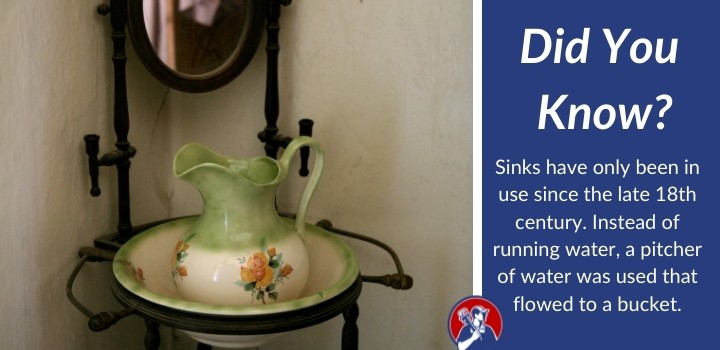
What Do You Look For In Under Sink Water Heaters?
When looking to buy an under the sink water heater for your home, you have a number of things to consider, including:
- Size of hot water heater
- How much hot water will I need from this device during peak times?
- How efficient is the unit?
- Can I install the water heater myself?
- Does it come in cool packaging with lots of colorful stickers? (Just kidding!)
Now let’s get into what matters…
Size of Unit
When installing a water heater under your sink, you have limited space to work with. You don’t want to overcrowd the area, possibly causing spills or damage.
Tankless units come in a more compact size than mini-tank units for people who need the device in a tight area.
Hot Water Requirements
You need your kitchen hot water heater to provide the correct amount of hot water to the desired device. To ensure you receive the proper amount of hot water, you need to consider your needs and the capabilities of the unit you purchase.
Under sink hot water heaters come in tank-style options or tankless options. If you buy a tank-style unit, you need a tank size that accommodates your needs. If you buy a tankless device, you need it to have an adequate water flow rating. Manufacturers measure water flow in Gallons Per Minute (GPM).
How do I know how much hot water capacity I need from my under the sink water heater?
Start by estimating how often people use the device each day and for how long, considering all fixtures connected to the water heater.
Generally speaking, sinks in the bathroom and kitchen run at a rate of 2.2 GPM (or 1.5 GPM if using a WaterSense Certified faucet). You will need a tankless unit that provides that water flow rating or higher.
For tank-style under the sink units, you will determine how long you have the faucet on. Using the rate of 2.2 GPM, you will use up a four-gallon tank in less than two minutes.
Efficiency
An efficient point of use water heater will help you save money on hot water costs. Water heaters come with a Uniform Environmental Factor (UEF) rating that indicates their efficiency. The higher the UEF rating, the more efficient the device. For example, a unit with a .92 UEF rating will run more efficiently than one with a .82 UEF rating.
Ease of Installation
If you plan to install the under sink water heater yourself, you should consider an electric model. However, be careful that the device doesn’t require more voltage than the current wiring provides. More powerful devices will require 240v. In that case, you may need an electrician to upgrade the wiring.
For gas water heaters, you need to ensure that you have a proper gas supply and the proper ventilation, both of which can get complicated. If you require an upgrade to the gas supply or new ventilation installation, that must be done by a professional.
Improper installation can void your warranty and possibly lead to damaging the device or your home. Furthermore, if you don’t ventilate a gas water heater properly, it can lead to your family breathing in the toxic gases.
See the following video to get more detail on how to install an under sink water heater:
Best Under Sink Water Heaters Reviewed
Now let’s explore our favorite units so you can decide on the perfect choice for your situation.
Our #1 Rated Pick: Bosch Electric 7 Gallon Mini-Tank Water Heater Tronic 3000
This 120v electric mini-tank water heater provides 7 gallons of water from a 29.5-pound unit at 98% efficiency. The device comes with a magnesium anode rod to prevent corrosion. Turn the knob on the unit to change the temperature, and verify power with the indicator light.
Pros
- 7-gallon tank
- 120v and 98% efficiency
- Inexpensive
Cons
- Large design
- Hard-wiring required
- No digital display
Our #2 Rated Pick: Ariston Andris 4 Gallon Mini-Tank Electric Water Heater
This electric 4-gallon mini-tank water heater efficiently provides hot water requirements of one or two sinks at 120v, and it plugs in instead of requiring hard wiring, making installation simple. Glass-lining helps protect the tank from corrosion. Use the knob on the device to control the temperature.
Pros
- Inexpensive
- Highly efficient
- Simple installation
Cons
- No digital display
- No anode rod
- Minimal hot water support
Our #3 Rated Pick: Rinnai V75iP Propane Tankless Hot Water Heater, 7.5 GPM
This high-end propane water heater provides a peak water flow of 7.5 GPM in warm climates (4.3 GPM with groundwater at 52°F) in a compact design and a clear digital display that shows the temperature setting.
You can also use the control panel to turn the device on or off or change the temperature. But you won’t need to, thanks to the connectivity feature provided with the EcoNet technology. The unit has an efficiency rating of .83 UEF, and it requires direct-vent ventilation.
Pros
- 7.5 GPM
- EcoNet technology
- Compact size
Cons
- Direct-vent design limits installation options
- Expensive
- Electricity required
Our #4 Rated Pick: Stiebel Eltron Tankless Water Heater – Tempra 24 Plus, 3.1 GPM
This 240v electric tankless water heater provides hot water at an ultra-high efficiency level of .99 UEF at a flow rate of 3.1 GPM with groundwater at 52°F, depending on your choice of three flow control options. It comes with a simple-to-read digital display that displays the temperature as well as the flow rate.
Pros
- Compact size
- Ultra-high 99% efficiency
- Silent
Cons
- Only compatible with 240v wiring
- Similarly priced devices offer higher water flow
- Expensive
Our #5 Rated Pick: ECOTOUCH ECO90 Electric Tankless Hot Water Heater, 1.5 GPM
This 240v electric tankless sink heater provides hot water at a flow rate of 1.5 GPM at a 40°F temperature rise at a high-efficiency rating of 98%. This can potentially support one sink, but it won’t support multiple devices or a shower.
It has an easy-to-read digital control panel that also allows you to change the temperature and switch between Fahrenheit or Celsius.
Pros
- Inexpensive
- Digital Display
- 98% efficient
Cons
- Minimal 1.5 GPM water flow
- 240v electrical requirements
- No mounting equipment
Final Thoughts On Under Sink Water Heaters
Under sink (or point of use) water heaters provide a great option when you want to enhance your current hot water system, especially in a remote or highly used fixture in your home. They can also help to heat water in off the grid settings.
Electric under sink water heaters tend to be easier to install (especially if 120v) and run at higher efficiency levels. Tankless options fit in tighter spaces, and they offer continuous hot water. Mini-tank options are less expensive, and provide adequate hot water for minimal needs.
Simply take into account your budget, space, and how many teenagers are using up hot water in your home to decide the best tankless choice for you.
Get Fast, Local Plumbing Service
Connect with an expert plumber in your local area to tackle any job – big or small. Find help with leaks, clogs, or full installations.
Select your service category on the form, provide your details, and an expert plumber will be in touch!
Plumbing Navigator is an informational site that connects visitors with local plumbers but does not directly provide plumbing services or operate as a licensed company.
FAQs for Under Sink Water Heaters
Why does it take so long for hot water to get to my kitchen sink?
Your water heater sends hot water to the desired fixture. If the faucet in question is far away from the water heater, it can take several seconds to get hot water. Your new under the sink water should resolve this problem.
What is the best under sink water heater?
Our top pink is the Bosh 7-Gallon mini-tank electric water heater since it runs at high efficiency levels, and a 7-gallon tank should adequately support most fixtures in your home. Plus, it won’t break the bank.
Are under sink water heaters worth it?
Under the sink water heaters will reduce water loss by providing hot water more quickly. They also save valuable time.
Can you put a tankless water heater under my sink?
Absolutely! You can get a tankless sink heater installed on your own or by a local contractor.
How do you get instant hot water under the sink?
Connect a tankless under the sink hot water heater to the fixtures that need it the most. You will get hot water instantly, and it won’t run out no matter how long you need it. Tank-style options will also provide hot water more quickly, but they will eventually run out.
Meet Your Plumbing Navigator

About Plumbing Navigator
We’re passionate about all things plumbing, and love sharing tips, “how-to”, and reviewing the latest products to help make your project a success!
Learn More Plumbing Tips
Want to tackle more plumbing projects? Check out these helpful guides!



